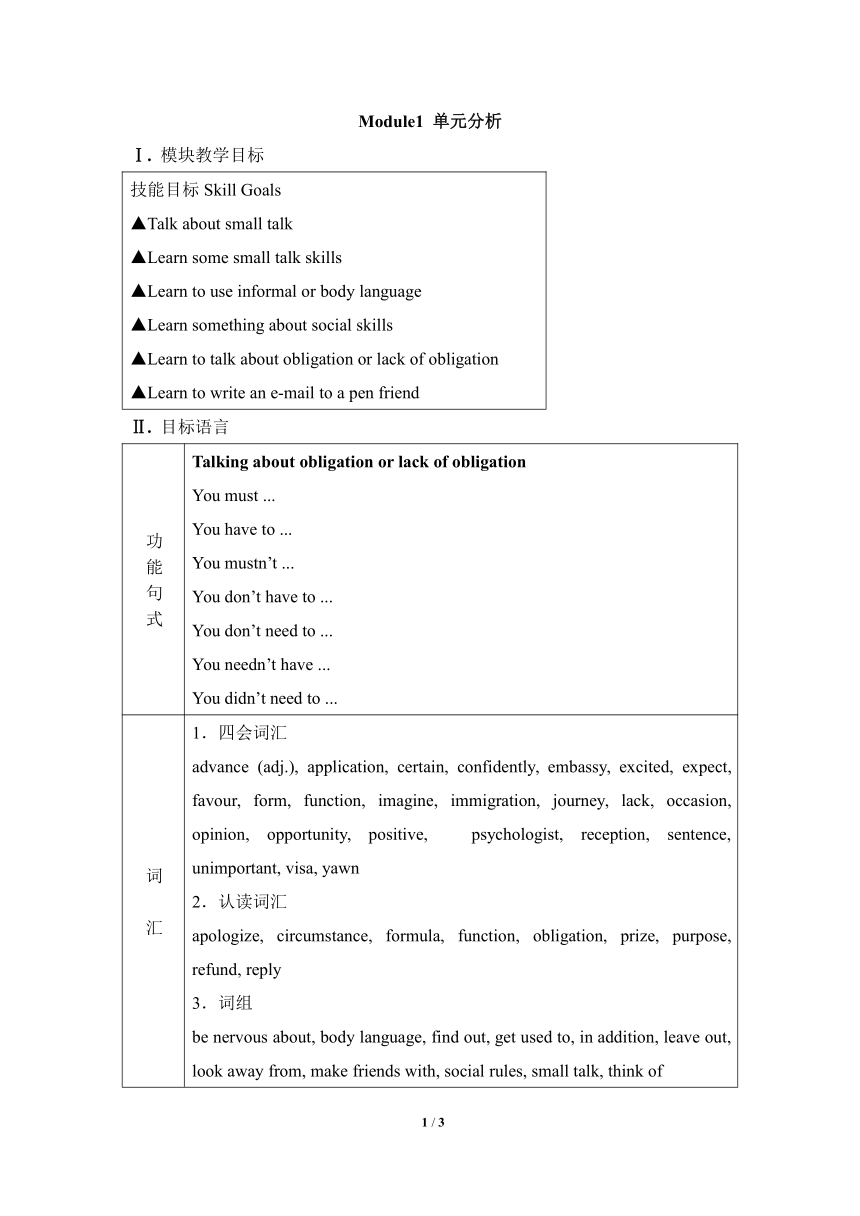外研版选修6 Module 1 Small Talk学案(单元分析)
文档属性
| 名称 | 外研版选修6 Module 1 Small Talk学案(单元分析) |  | |
| 格式 | doc | ||
| 文件大小 | 25.0KB | ||
| 资源类型 | 教案 | ||
| 版本资源 | 外研版 | ||
| 科目 | 英语 | ||
| 更新时间 | 2023-02-17 12:45:55 | ||
图片预览

文档简介
Module1 单元分析
Ⅰ. 模块教学目标
技能目标Skill Goals▲Talk about small talk▲Learn some small talk skills▲Learn to use informal or body language▲Learn something about social skills ▲Learn to talk about obligation or lack of obligation▲Learn to write an e-mail to a pen friend
Ⅱ. 目标语言
功 能 句 式 Talking about obligation or lack of obligationYou must ...You have to ...You mustn’t ...You don’t have to ...You don’t need to ...You needn’t have ...You didn’t need to ...
词 汇 1.四会词汇advance (adj.), application, certain, confidently, embassy, excited, expect, favour, form, function, imagine, immigration, journey, lack, occasion, opinion, opportunity, positive, psychologist, reception, sentence, unimportant, visa, yawn 2.认读词汇apologize, circumstance, formula, function, obligation, prize, purpose, refund, reply3.词组be nervous about, body language, find out, get used to, in addition, leave out, look away from, make friends with, social rules, small talk, think of
语法 Didn’t need to do and needn’t have done.
重点句子 1. You needn’t worry about situations like these if you have good social skills. 2. In some countries, for example, you have to ...; in other countries, you don’t need to. 3. I wonder if you would be kind enough to answer these questions. 4. By continuing with the AAA model, the conversation continues. 5. It is polite to ask questions about people’s family, home, job, hobbies, garden, pets and studies. 6. You soon find you needn’t have worried and that you have made some new friends.
Ⅲ. 教材分析与教材重组
1. 教材分析
本模块以Small Talk为话题,旨在通过教学,使学生对各种不同的闲聊话题、技巧、注意事项、社交方法、规则等加以了解并能够学会用small talk和别人进行交流。学会使用非正式的日常用语;能正确运用“责任义务和无责任义务”的表达法;学会读、写电子邮件。
1.1 INTRODUCTION提供了四本权威词典对small talk的解释,让学生了解small talk的含义、small talk涉及的话题以及small talk 和serious talk的区别。
1.2 VOCABULARY AND READING是一篇介绍社交技巧的说明文。文中介绍了交际活动中应注意的事项、社交技巧等。
1.3 FUNCTION 部分学习“责任义务和无责任义务”的表达法。
1.4 READING AND LISTENING部分要求学生朗读三段对话,选出对话发生的地点;根据对话内容回答问题;并通过听取对话录音回答问题、完成句子。
1.5 GRAMMAR学习并使用didn’t need to和needn’t have done结构。
1.6 READING AND WRITING 要求学生阅读并回复网友的电子邮件。
1.7 EVERYDAY ENGLISH 学习非正式交际用语中词汇的省略法。
1.8 SPEAKING 部分要求学生根据问题和提示,以small talk为话题展开小组活动并继续READING AND LISTENING中的对话。
1.9 CULTURAL CORNER部分介绍了英语国家“small talk”的一种较为成功的模式——AAA model.
1.10 TASK部分要求学生在掌握small talk相关知识的基础上,收集课内外small talk中经常使用的表达并鼓励学生实现资源共享,编写一个供全班同学使用的小册子。
2. 教材重组
2.1 将INTRODUCTION, EVERYDAY ENGLISH,SPEAKING部分整合为一节口语课。
2.2 将READING AND LISTENING和WORKBOOK中的Listening and speaking 部分整合为一节听力课。
2.3 将VOCABULARY AND READING和WORKBOOK中的Vocabulary部分整合为一节阅读课。
2.4 将CULTURAL CORNER, TASK与WORK-BOOK中的Reading部分整合为一节泛读课。
2.5 将FUNCTION,GRAMMAR和WORK-BOOK中的Grammar部分整合为一节语法课。
2.6 将READING AND WRITING 与WORKBOOK中的Speaking and writing部分整合为一节写作课。
1 / 3
Ⅰ. 模块教学目标
技能目标Skill Goals▲Talk about small talk▲Learn some small talk skills▲Learn to use informal or body language▲Learn something about social skills ▲Learn to talk about obligation or lack of obligation▲Learn to write an e-mail to a pen friend
Ⅱ. 目标语言
功 能 句 式 Talking about obligation or lack of obligationYou must ...You have to ...You mustn’t ...You don’t have to ...You don’t need to ...You needn’t have ...You didn’t need to ...
词 汇 1.四会词汇advance (adj.), application, certain, confidently, embassy, excited, expect, favour, form, function, imagine, immigration, journey, lack, occasion, opinion, opportunity, positive, psychologist, reception, sentence, unimportant, visa, yawn 2.认读词汇apologize, circumstance, formula, function, obligation, prize, purpose, refund, reply3.词组be nervous about, body language, find out, get used to, in addition, leave out, look away from, make friends with, social rules, small talk, think of
语法 Didn’t need to do and needn’t have done.
重点句子 1. You needn’t worry about situations like these if you have good social skills. 2. In some countries, for example, you have to ...; in other countries, you don’t need to. 3. I wonder if you would be kind enough to answer these questions. 4. By continuing with the AAA model, the conversation continues. 5. It is polite to ask questions about people’s family, home, job, hobbies, garden, pets and studies. 6. You soon find you needn’t have worried and that you have made some new friends.
Ⅲ. 教材分析与教材重组
1. 教材分析
本模块以Small Talk为话题,旨在通过教学,使学生对各种不同的闲聊话题、技巧、注意事项、社交方法、规则等加以了解并能够学会用small talk和别人进行交流。学会使用非正式的日常用语;能正确运用“责任义务和无责任义务”的表达法;学会读、写电子邮件。
1.1 INTRODUCTION提供了四本权威词典对small talk的解释,让学生了解small talk的含义、small talk涉及的话题以及small talk 和serious talk的区别。
1.2 VOCABULARY AND READING是一篇介绍社交技巧的说明文。文中介绍了交际活动中应注意的事项、社交技巧等。
1.3 FUNCTION 部分学习“责任义务和无责任义务”的表达法。
1.4 READING AND LISTENING部分要求学生朗读三段对话,选出对话发生的地点;根据对话内容回答问题;并通过听取对话录音回答问题、完成句子。
1.5 GRAMMAR学习并使用didn’t need to和needn’t have done结构。
1.6 READING AND WRITING 要求学生阅读并回复网友的电子邮件。
1.7 EVERYDAY ENGLISH 学习非正式交际用语中词汇的省略法。
1.8 SPEAKING 部分要求学生根据问题和提示,以small talk为话题展开小组活动并继续READING AND LISTENING中的对话。
1.9 CULTURAL CORNER部分介绍了英语国家“small talk”的一种较为成功的模式——AAA model.
1.10 TASK部分要求学生在掌握small talk相关知识的基础上,收集课内外small talk中经常使用的表达并鼓励学生实现资源共享,编写一个供全班同学使用的小册子。
2. 教材重组
2.1 将INTRODUCTION, EVERYDAY ENGLISH,SPEAKING部分整合为一节口语课。
2.2 将READING AND LISTENING和WORKBOOK中的Listening and speaking 部分整合为一节听力课。
2.3 将VOCABULARY AND READING和WORKBOOK中的Vocabulary部分整合为一节阅读课。
2.4 将CULTURAL CORNER, TASK与WORK-BOOK中的Reading部分整合为一节泛读课。
2.5 将FUNCTION,GRAMMAR和WORK-BOOK中的Grammar部分整合为一节语法课。
2.6 将READING AND WRITING 与WORKBOOK中的Speaking and writing部分整合为一节写作课。
1 / 3
